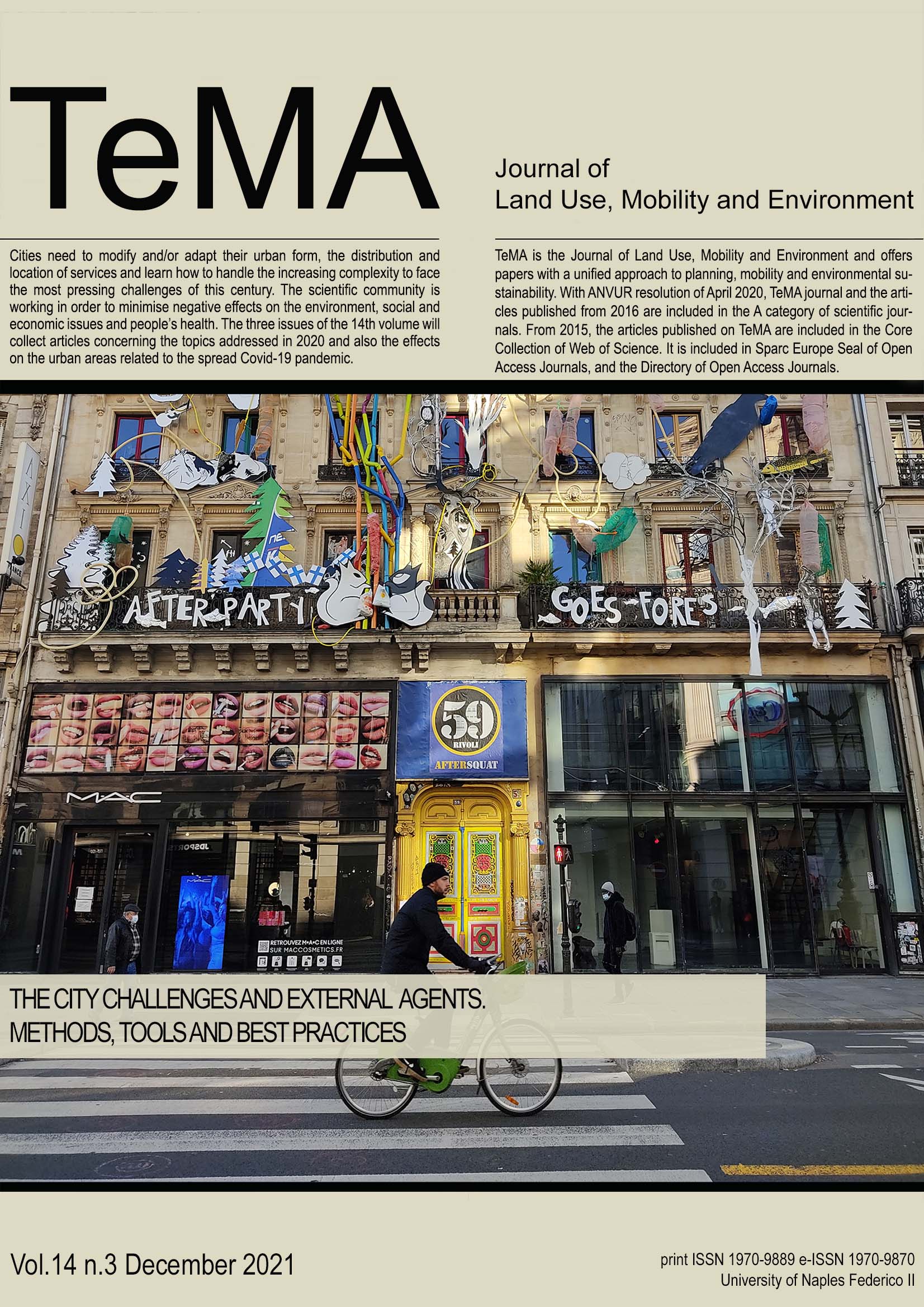Ecological transition: innovation in cities
Abstract
Starting from the relationship between urban planning and mobility management, TeMA has gradually expanded the view of the covered topics, always remaining in the groove of rigorous scientific in-depth analysis. This section of the Journal, Review Notes, is the expression of a continuous updating of emerging topics concerning relationships between urban planning, mobility and environment, through a collection of short scientific papers written by young researchers. The Review Notes are made of four parts. Each section examines a specific aspect of the broader information storage within the main interests of TeMA Journal.
In particular, the Urban planning literature review section aims at presenting recent books and journals, within global scientific panorama, on selected topics and issues.
Starting from the relationship between urban planning and mobility management, TeMA has gradually expanded the view of the covered topics, always remaining in the groove of rigorous scientific in-depth analysis. This section of the Journal, Review Notes, is the expression of a continuous updating of emerging topics concerning relationships between urban planning, mobility and environment, through a collection of short scientific papers written by young researchers. The Review Notes are made of four parts. Each section examines a specific aspect of the broader information storage within the main interests of TeMA Journal.
In particular, the Urban planning literature review section aims at presenting recent books and journals, within global scientific panorama, on selected topics and issues.
This contribution focuses on one of the most significant features of ecological transition which concerns digitalisation and innovation. In particular, for the third issue of TeMA Journal 2021, this section of Review Note proposes a literature overview of how the vocation for innovation and Industry 4.0 can change the structure of neighbourhoods and entire cities. The contribution shows some significant best practices and interesting books and journals which delved into the topic.
Downloads
References
Aldegheishem, A. (2019). Success Factors of Smart Cities: A Systematic Review of Literature from 2000-2018. TeMA - Journal of Land Use, Mobility and Environment, 12(1), 53-64. https://doi.org/10.6092/1970-9870/5893
Clark, J. (2020). Uneven innovation: The work of smart cities. Columbia University Press. ISBN 978-023-118496-0
Concilio, G. & Tosoni, I. (2019). Innovation Capacity and the City: The Enabling Role of Design (p. 101). Springer Nature. ISBN 978-3-030-00122-3
Florida, R., Adler, P. & Mellander, C. (2017). The city as innovation machine. Regional Studies. 51:1, 86-96, https://doi.org/10.1080/00343404.2016.1255324
Gargiulo, C., & Russo, L. (2017). Cities and Energy Consumption: a Critical Review. TeMA - Journal of Land Use, Mobility and Environment, 10(3), 259-278. https://doi.org/10.6092/1970-9870/5182
Guida, C., & Natale, F. (2021). Ecological transition: which transactions?. TeMA - Journal of Land Use, Mobility and Environment, 14(1), 93-98. https://doi.org/10.6092/1970-9870/7878
Landry, C. (2012). The Creative City. A toolkit for urban innovators. Earthscan – Routledge, London. ISBN 978-1-84407-598-0
Partenay, V., Riederer, P., & Caccavelli, D. (2015). Energy Refurbishment of a Scientific & Technology Park using a District Simulation Platform: Case Study of Sophia-Antipolis. ClimaMed.
Zanini, P. (2019). Il Portfolio Management come metodologia per la gestione dei Living Labs: l'Esperienza di Torino City Lab. Doctoral dissertation, Politecnico di Torino. Retrieved from: http://webthesis.biblio.polito.it/id/eprint/13534
Zukin, S. (2020). The innovation complex: Cities, tech, and the new economy. Oxford University Press, Oxford (UK). ISBN 978-0-19-008383-0
Copyright (c) 2021 TeMA - Journal of Land Use, Mobility and Environment

This work is licensed under a Creative Commons Attribution 4.0 International License.
Authors who publish in this journal agree to the following:
1. Authors retain the rights to their work and give in to the journal the right of first publication of the work simultaneously licensed under a Creative Commons License - Attribution that allows others to share the work indicating the authorship and the initial publication in this journal.
2. Authors can adhere to other agreements of non-exclusive license for the distribution of the published version of the work (ex. To deposit it in an institutional repository or to publish it in a monography), provided to indicate that the document was first published in this journal.
3. Authors can distribute their work online (ex. In institutional repositories or in their website) prior to and during the submission process, as it can lead to productive exchanges and it can increase the quotations of the published work (See The Effect of Open Access)

